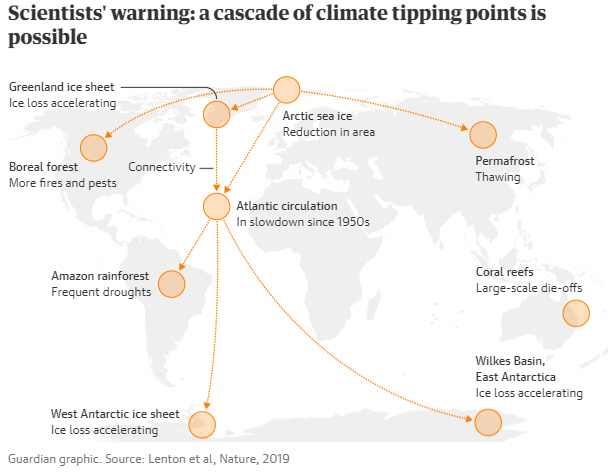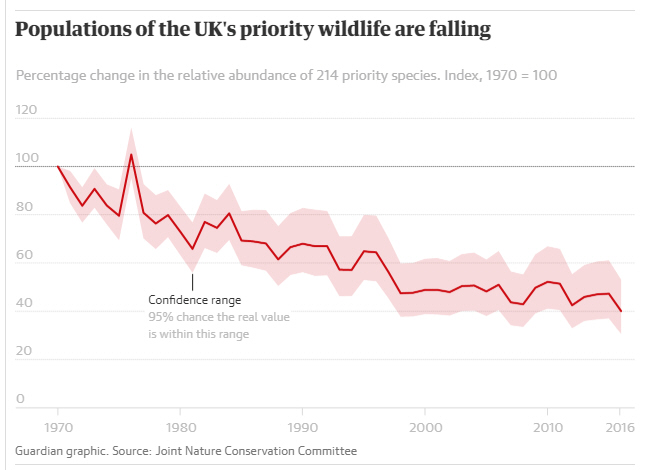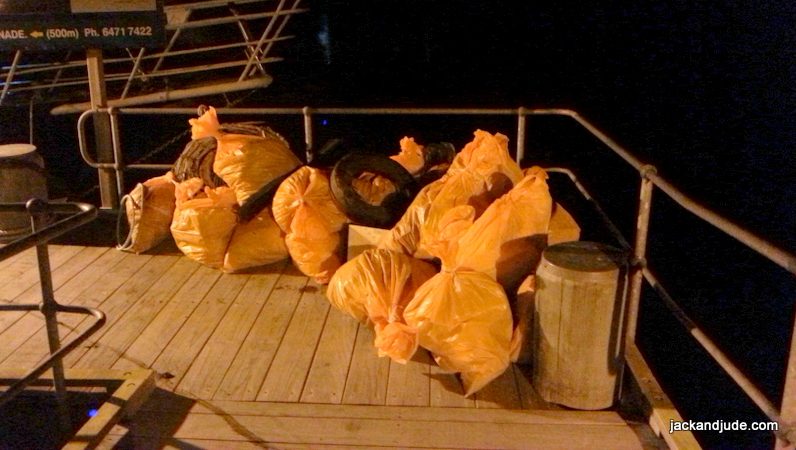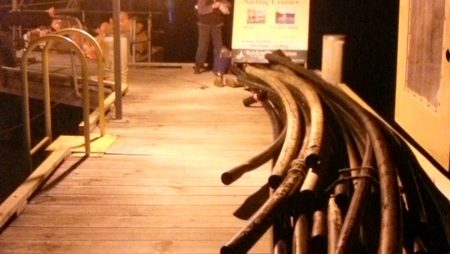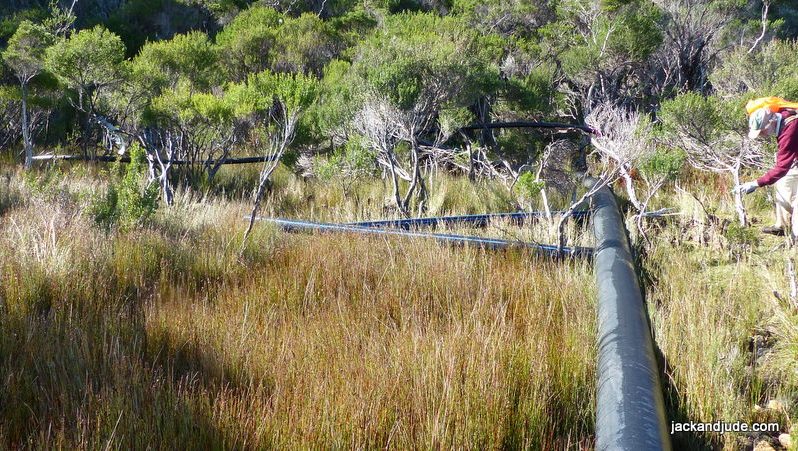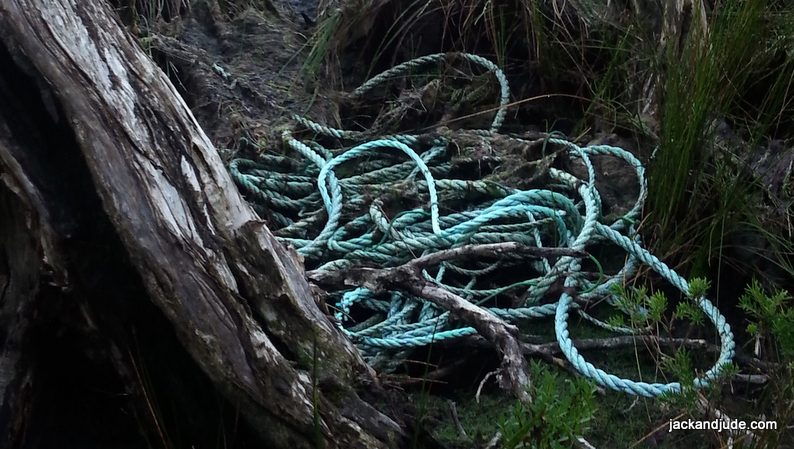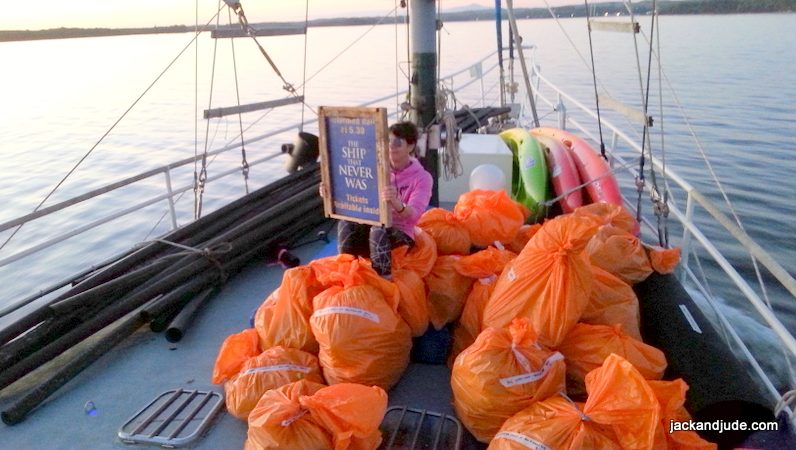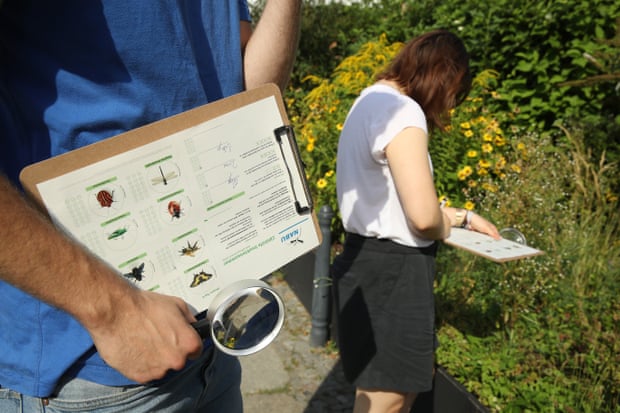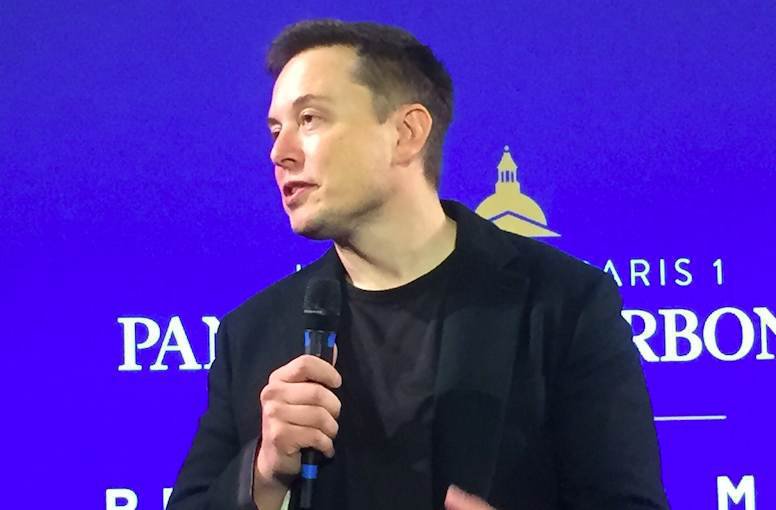On this Page:
- The world ‘may have crossed tipping points’ – 28 Nov 2019
- Australia pushes fossil fuels with the zeal of a drug lord – 21 Nov 2019
- UK’s Wildlife plummeted – 4 Oct 2019
- Beef industry responsible for 94% of land cleared in GBR catchment – 7 Aug 2019
- ‘Unprecedented’: 100 Arctic wildfires burn in worst ever season – 29 July 2019
- All-time temperature records tumble again as heatwave sears Europe – 25 July 2019
- BHP announces $US400m plan to combat ‘indisputable’ climate crisis – 23 July 2019
- Macquarie Harbour Fish Farm Update
- Arctic permafrost thawing 70 years sooner than predicted – 19 Jun 2019
- Clean energy to be a ‘pathway to prosperity’ for Northern Territory – 20 Jun 2019
- Plummeting insect numbers ‘threaten collapse of nature’ – 10 Feb 2019
- Our Children are protesting for a better future – 20 Nov 2018
- SEC allows Musk to resume plotting end of fossil fuel era – 10 Oct 2018
- Shell and Exxon’s secret 1980s climate change warnings – 19 Sept 2018
- New coal power is NOT the answer for cheaper electricity bills – 2 Sept 2018
- This may sound absurd – Camping is costly – 15 Aug 2018
- Putting the Capital Back in Nature – 1 July 2018
- Japan set to resume commercial whaling – 22 June 2018
- Stop the spread of dangerous marine pests – 28 Jun 2018
- Bill Shorten may not be the leader we need – 28 Feb 2018
- Gunge Everywhere – 16 Feb 2018
- Crown-of-thorns starfish are at it again! – 5 Jan 2018
The world ‘may have crossed tipping points’
Scary headline that spells doom for our children
Cascade of unstoppable events _Read this to understand
28 Nov 2019 – The researchers, writing in a commentary article in the journal Nature, acknowledge that the complex science of tipping points means great uncertainty remains. But they say the potential damage from the tipping points is so big and the time to act so short, that “to err on the side of danger is not a responsible option”. They call for urgent international action.
Australia pushes fossil fuels with the zeal of a drug lord

21 Nov 2019
Australia is now the second-largest gas exporter, the second-largest thermal coal exporter and the largest metallurgical coal exporter on the planet. We push our products with the zeal of a drug lord – we do not care about the future misery we are creating.
Greenhouse gas emissions are not reducing
Global greenhouse gas emissions each year are not reducing, they are accelerating. The scientific community has been issuing increasingly urgent calls for rapid reductions in emissions with the foresight that global warming trends will bring these kinds of “unprecedented” conditions. The federal government chooses to ignore them. Three decades on from the first report of the Intergovernmental Panel on Climate Change, Australia’s emissions are growing again, as are our fossil fuel developments.
[Return to Contents]
UK’s Wildlife plummeted
Quarter of mammals, nearly half of birds at risk of extinction
4 Oct 2019
The State of Nature report finds the losses to all animals, plants and marine life show no sign of letting up, despite some successes in protecting individual species. It found that 41% of species have decreased in abundance, while just 26% have increased.
A quarter of UK mammals and nearly half of the birds assessed are at risk of extinction, according to the report, which was produced by a coalition of more than 70 wildlife organisations and government conservation agencies. When plants, insects and fungi are added, one in seven of the 8,400 UK species assessed are at risk of being completely lost, with 133 already gone since 1500.
Beef industry responsible for 94% of land cleared
in Great Barrier Reef catchments
Spatial data analysis: ‘Beef is number one’ driver of deforestation crisis
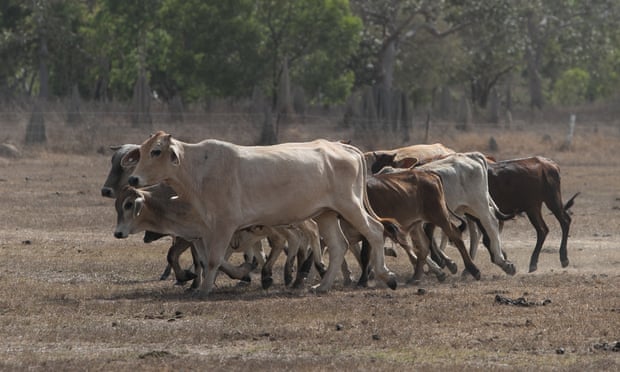
More than 90% of land clearing in Great Barrier Reef catchments over a five-year period was attributable to the beef industry, according to new analysis by The Wilderness Society. The report analysed the more than 1.6m hectares cleared in Queensland between 2013 and 2018 and found that 73% of clearing across the state occurred for beef production.
7 Aug 2019 – Years ago, humanity could do what we wanted, our impact on the planet was so infinitesimal that the creation patched up and carried on. But you know how it is when you get too much of an irritant, then every occurrence causes a rash, an itch, an infection, until it overwhelms the mind and body. Some die from this unless change is made. Earth, the creation, has had too much. Our interference with the atmosphere is sprouting reactions; our mucking about with the wild kingdom is having a roll-on effect. Our loss of love for the creation is a landslide destroying all in its path. Mankind, humanity, our children, the future of our unique brilliance is threatened.
Let us not lose the opportunity of becoming one with the creation, that is the real purpose of our lives and not a narcissistic glorification of our achievements and worth.
[Return to Contents]
‘Unprecedented’: more than 100 Arctic wildfires burn in worst ever season
Huge blazes in Greenland, Siberia and Alaska are producing plumes of smoke that can be seen from space
26 July 2019 – The Arctic is suffering its worst wildfire season on record, with huge blazes in Greenland, Siberia and Alaska producing plumes of smoke that can be seen from space.
The Arctic region has recorded its hottest June ever. Since the start of that month, more than 100 wildfires have burned in the Arctic circle. In Russia, 11 of 49 regions are experiencing wildfires.
The World Meteorological Organization (WMO), the United Nations’ weather and climate monitoring service, has called the Arctic fires “unprecedented”.
[MORE]
[Return to Contents]
All-time temperature records tumble again as heatwave sears Europe
Highs in Germany, Netherlands and Belgium exceeded for second time in 24 hours
25 July 2019 – Germany, the Netherlands and Belgium have recorded all-time national temperature highs for the second day running and Paris has had its hottest day ever as the second dangerous heatwave of the summer sears western Europe.
The extreme temperatures follow a similar heatwave last month that made it the hottest June on record. Scientists say the climate crisis is making summer heatwaves five times more likely and significantly more intense. [MORE]

A board in an office building in Stuttgart reads 41C as a new record high temperature was recorded in Germany. Photograph: Marijan Murat/AFP/Getty Images
BHP announces $US400m plan to combat ‘indisputable’ climate crisis
World locked in an ideological struggle while specie die and we boil
23 July 2019 – The chief executive of the world’s largest mining company has endorsed drastic action to combat global warming, which he calls “indisputable”, and an emerging crisis.
“The planet will survive. Many species may not,” the BHP chief executive officer, Andrew Mackenzie, told a business breakfast in London on Tuesday. “This is a confronting conclusion but as a veteran geologist once said, ‘you can’t argue with a rock’.”
Mackenzie endorsed carbon pricing but said it was not enough to combat the looming threat of mass extinctions and major sea rises.
He announced BHP was spending $US400m ($A570m) to create a climate investment program to reduce emissions from its own operations as well as those generated from its resources.
[Return to Contents]
Macquarie Harbour Fish Farm Update
The War on Waste has awoken many to the tragic side of plastic.
But Jack and Jude are no-strangers to this.
In the last fifty years we’ve seen increasing human trash on the seas and shores, and very isolated isles and atolls.
Therefore it should not be surprising that we’ve been rising the alarm about plastic fish farm trash in Macquarie Harbour, which is a very special case for several reasons. One is that it is a World Heritage area of significance, legally protected by international treaties. Secondly, it’s a nearly closed body of water that little escapes. And that’s an interesting point.
What we are finding in Macquarie Harbour illustrates just how much plastic waste escapes from fish farm leases. What we see in that nearly landlocked harbour represents what is typically escaping from all the other farm leases and then gets washed away into the wider seas. Of the fish farms In Macquarie Harbour, Tassal have been in operation since 1986. We’ll get to that in a moment.
One example of the Fish Farm Trash unleashed upon the shores of World Heritage Macquarie Harbour
Macquarie Harbour Farms
Shifting attention to Macquarie Harbour with its insidious problem of fish farm ropes breaking down into micro-plastic, we received an update from the head of Tassal’s Aquaculture, Mr. Mark Asman.
In an email he told us that he’d gone to Macquarie Harbour and walked the shores of Brisbane Bay at the location of our last expose on Fish Farm Trash, and had seen various pieces of debris. And that he has been told the amount of debris is declining (with each successive effort), but it needs continuous effort to get where we want.
He wrote, “So the plan will be:
1. Keep on the culture side by “stopping it at the source” (we think this is having a real impact, just takes time) ,
2. Continue the regular shoreline clean-ups by the staff and others.
3. Working on a solution like you mention, a permanent crew to walk the shores…
I hope to have more clarity on this when you return.”
That sounds encouraging. And we sure hope it happens and is not just illusory promises. Mark has been talking about “changing the culture” from our very first conversation.
In replying to Mark’s email, we pointed out that Tassal has been in the fish farming business since 1986. That’s thirty-three years. And that Tassal employs 1261 people. We know many and they are good people who work hard to produce farmed salmon at approximately 20 leases in six regional areas within Tasmania. Tassal is a public company listed on the ASX. In 2017, Tassal earned a NET profit of A$58.08 million, that’s the net increase in shareholders’ equity.
Sustainability
Tassal prides itself on not only what it produces but how it produces it. Check out their website. “Our consumers can be confident that the Tassal Salmon has been raised by an environmentally and socially responsible company.” In July last year, Tasmania’s Department of Primary Industries (DPIPWE) introduced a “zero tolerance” for marine debris. And that for a company claiming such high environmental standards, achieving “zero tolerance” for marine debris should rank above all else.
In our email to Mark, we mentioned that what we recorded in Macquarie Harbour these last couple of years would have been going on for many years at every fish farm lease. The difference? – All that trash floated away across the oceans.
And we had some proactive suggestions to reduce fish farm trash:
- permanent crew walking the shores collecting trash
- lengthened the soft eye net ropes so they can be secured to the pens – many blow away.
- filter out the micro-algae when cleaning the nets instead of releasing it to drift round the harbour (the gunge)
- filter out the molluscs when cleaning the nets instead of releasing them back into the harbour.
First Community Harbour Clean Up – April 2017
Scientists shocked
Arctic permafrost thawing 70 years sooner than predicted
Ice blocks frozen solid for thousands of years destabilized –
‘The climate is now warmer than at any time in last 5,000 years’

An iceberg melts in Kulusuk, Greenland, near the Arctic circle. The far northern region is warming twice as fast as the rest of the globe. Photograph: John Mcconnico/AP
19 June 2019 – Permafrost at outposts in the Canadian Arctic is thawing 70 years earlier than predicted, an expedition has discovered, in the latest sign that the global climate crisis is accelerating even faster than scientists had feared.
A team from the University of Alaska Fairbanks said they were astounded by how quickly a succession of unusually hot summers had destabilised the upper layers of giant subterranean ice blocks that had been frozen solid for millennia.
“What we saw was amazing,” Vladimir Romanovsky, a professor of geophysics at the university, told Reuters. “It’s an indication that the climate is now warmer than at any time in the last 5,000 or more years.“
[Return to Contents]
Clean energy found to be a ‘pathway to prosperity’ for Northern Territory
Renewable energy is not only a money-spinner for the NT, it can also help the fossil fuel industries expand

The report estimates replacing Darwin’s gas-fired electricity with solar power and batteries could cut electricity bills by about 30%. Photograph: Steven David Miller/Getty Images/Nature Picture Library
20 June 2019 – A new report says the NT economy could be transformed through incentives for renewable-powered manufacturing and downstream minerals processing, targets for mines to transition to 100% clean energy and electric machinery by 2030 and support for Indigenous communities to be equity partners in zero-carbon developments. It calls on the NT and federal governments to fund common infrastructure to turn what is known as the 10-gigawatt vision into a reality – for example, transmission lines connecting Darwin and Alice Springs to allow clean energy developments in remote locations.
Eytan Lenko, chairman of the thinktank Beyond Zero Emissions, commissioned the report while living in Darwin in 2018 after seeing divisions in the community between people concerned about the health of the economy and those opposed to fracking. He says the full plan would cost businesses about $20bn out to 2030 on today’s prices, though the scale of the investment is expected to fall as clean tech becomes cheaper. It estimates it could create more than 8,000 jobs and yield more than $2bn in annual export revenue.
[Return to Contents]
Plummeting insect numbers ‘threaten collapse of nature’
The analysis, published in the journal Biological Conservation, says intensive agriculture is the main driver of the declines, particularly the heavy use of pesticides. Urbanisation and climate change are also significant factors.
“The main cause of the decline is agricultural intensification,” said Francisco Sánchez-Bayo, at the University of Sydney, Australia, who wrote the review with Kris Wyckhuys at the China Academy of Agricultural Sciences in Beijing. “That means the elimination of all trees and shrubs that normally surround the fields, so there are plain, bare fields that are treated with synthetic fertilisers and pesticides.” He said the demise of insects appears to have started at the dawn of the 20th century, accelerated during the 1950s and 1960s and reached “alarming proportions” over the last two decades.
He thinks new classes of insecticides introduced in the last 20 years, including neonicotinoids and fipronil, have been particularly damaging as they are used routinely and persist in the environment: “They sterilise the soil, killing all the grubs.” This has effects even in nature reserves nearby; the 75% insect losses recorded in Germany were in protected areas.
[Return to Contents]
Our Children are protesting for a better future

‘Strike 4 Climate Action’ brings thousands of students together in defiance of prime minister’s warning.
Thousands of schoolchildren across Australia walked out of class on Friday to demand action by the federal government on climate change.
The “Strike 4 Climate Action”, inspired by 15-year-old Swedish student Greta Thunberg, brought together children in capital cities and 20 regional centres such as Ballarat, Newcastle, Townsville and Cairns. A large protest was also held in Hobart on Thursday.
More than a thousand primary and secondary students filled Sydney’s Martin Place and students in Melbourne marched through the streets, bringing traffic to a standstill.
The prime minister, Scott Morrison, had earlier this week urged students this week not to take part and told them to be “less activist”.
Our Resources Minister Matt Canavan told the kids,
“Best thing you’ll learn by going to a protest is how to join the dole queue.”
On Friday, the resources minister Matt Canavan said he would prefer students to learn about mining and science. “These are the type of things that excite young children and we should be great at it as a nation,” he told 2GB radio. “The best thing you’ll learn by going to a protest is how to join the dole queue.”

In Sydney, student Jean Hinchliffe, 14, took to the stage and told her fellow students the protest was just getting started. “This is our first strike,” she said. “Our first action. And it is just the beginning. And we’ll keep doing it until something is done.”
Lucie Atkin-Bolton, 11, the school captain of Forest Lodge public school, said she had been let down by politicians.
“I wish I didn’t have to be here today,” she said. “I’m the school captain at my primary school. We’ve been taught what it means to be a leader. You have to think about other people.
“When kids make a mess, adults tell us to clean it up and that’s fair. But when our leaders make a mess, they’re leaving it to us to clean up.”
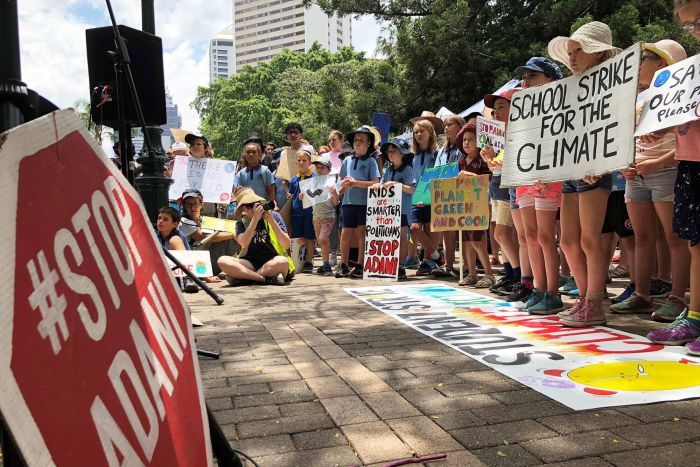
[Return to Contents]
GOOD NEWS
SEC allows Musk to resume plotting end of fossil fuel era
“It is important we accelerate the transition to sustainable energy,” Musk said. “We are playing a crazy game with the atmosphere and the oceans.”
He plans to do that by using renewables, and particularly solar, to power the world, balanced and stored in batteries, like his Tesla Powerwalls and the Tesla big battery in South Australia, along with other forms of storage, and electric vehicles replacing the internal combustion engine for cars, buses and trucks.
[Return to Contents]
Shell and Exxon’s secret 1980s climate change warnings
They kept it a secret! – They knew 30 years ago that their products destroy our climate!
In the 1980s, oil companies like Exxon and Shell carried out internal assessments of the carbon dioxide released by fossil fuels, and forecast the planetary consequences of these emissions. In 1982, for example, Exxon predicted that by about 2060, CO2 levels would reach around 560 parts per million – double the pre-industrial level – and that this would push the planet’s average temperatures up by about 2°C over then-current levels (and even more compared to pre-industrial levels).

Exxon’s private prediction of the future growth of carbon dioxide levels (left axis) and global temperature relative to 1982 (right axis). Elsewhere in its report, Exxon noted that the most widely accepted science at the time indicated that doubling carbon dioxide levels would cause a global warming of 3°C. Illustration: 1982 Exxon internal briefing document
Later that decade, in 1988, an internal report by Shell projected similar effects but also found that CO2 could double even earlier, by 2030. Privately, these companies did not dispute the links between their products, global warming, and ecological calamity. On the contrary, their research confirmed the connections.
Shell’s assessment foresaw a one-meter sea-level rise, and noted that warming could also fuel disintegration of the West Antarctic Ice Sheet, resulting in a worldwide rise in sea level of “five to six meters.” That would be enough to inundate entire low-lying countries.
Shell’s analysts also warned of the “disappearance of specific ecosystems or habitat destruction,” predicted an increase in “runoff, destructive floods, and inundation of low-lying farmland,” and said that “new sources of freshwater would be required” to compensate for changes in precipitation. Global changes in air temperature would also “drastically change the way people live and work.” All told, Shell concluded, “the changes may be the greatest in recorded history.”
Source: The Guardian Australian Edition
[Return to Contents]
The reality is –
New coal power is NOT the answer for cheaper electricity bills
In a recent report, the highest authority states that based on deep, sophisticated modelling which looked at the most economical way to replace our ageing coal plants as they retire, the Australian Energy Market Operator (AEMO), who is responsible for operating Australia’s gas and electricity markets and power systems, said, “The lowest cost replacement for this retiring capacity and energy will be a portfolio of resources, including solar (28 gigawatts), wind (10.5 GW) and storage (17 GW and 90 GWh), complemented by 500 megawatts of flexible gas plant and transmission investment.”
New coal power didn’t rate a mention! And no wonder. Prices of electricity from new renewable energy projects are already far cheaper than the likely price from the new-generation coal plants some Coalition MPs want to see built.
Renewable power prices going down
Last year, Origin Energy stunned the market by signing a long-term deal to buy electricity from the Stockyard Hill windfarm being developed west of Ballarat in Victoria, reportedly at less than $55 a megawatt hour.
That set a new benchmark. AGL swiftly followed suit at its Coopers Gap windfarm project in south-east Queensland, which is set to be the largest wind farm in Australia.
SAVE EARTH NOW says, That’s Good News for the planet!
Download the AEMO study and read the truth about renewable vs coal
[Return to Contents]
This may sound absurd – Camping is Expensive
We know that this may sound absurd in today’s view of economics, but we just got back from Tenterfield, birthplace of the nation and home to Australia’s biggest rock, where we noticed that to camp next to The Rock would cost $68 a night for a family of five with children over five years. That’s $12 a head, plus another $8 for the car, bring your own camping gear.
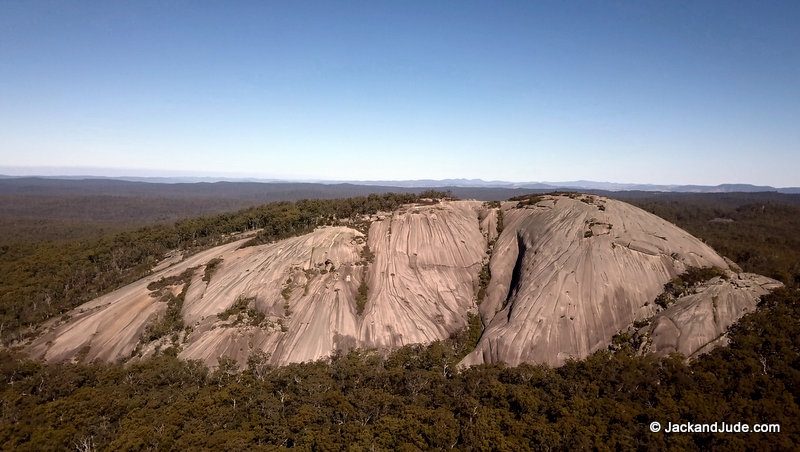
Bald Rock
Australia’s largest granite rock
Is that Expensive ?
To let your children explore the magic of Nature for only three days of camping would cost a family of five more than two-hundred dollars in fees. Wow!
That got us wondering just how many families actually camp at the rock and climb it for the marvellous views to far forested horizons around pockets of bold granite sculptured by Nature. Having done this ourselves many times, we also wondered if schools brought classes to Nature, and if the Scouts have excursions to our Parks for learning outdoor skills with wholesome exercise as a bonus.

Life Afloat ~ The Four J’s
Having raised our children predominately surrounded by Nature, we know that exposing our youth to more Nature created inquizative minds and strong bodies. That’s got to be better for all of us and Earth, and the other creatures.
Parks should be FREE
So, maybe Parks should be free, with learned educators telling stories of what’s surrounds them. That always worked when we were kids. We think it still works for today’s children. Instead of giving Parks the minimum budget to look after the Nation’s Estate and have minimal activities and restricted access, maybe we should be giving Parks a much higher budget so that we create good healthy kids with an appetite to Save Earth Now.
It has been our experience that children really turn on to little critters in the realness of the natural world and if someone inspirational told them about the creation, and how it works, it would make sense to them and they’d want to restore balance. And for the rest of their happy long lives, they would think about doing just that. Think about it.

Get the kids outside and connected to Nature and less in front of the screens.
Putting the Capital Back in Nature
The word Nature was first used in the 12th century and has come to represent all of the phenomena of the physical world collectively, including plants, animals, the landscape, and all the other features, forces, and processes that happen or exist independently of people, such as the weather, the sea, mountains.
Before the Scientific Revolution, Nature was considered in a spiritual context, deserving of respect and admiration. But now that we have come to use Nature’s animals, freshwater, minerals, forests in a non-sustainable way and destroyed some of the balance, we have replaced the capital letter “N” in Nature with a lower case one.
A coincidence? Perhaps.
[Return to Contents]
Skip a meal instead of spoiling a good story
Japan set to resume commercial whaling

Image of three dead Minke whales on the deck of the Japanese whaling vessel Nisshin Maru in 2014. AP Photo/Tim Watters/Sea ShepherdSource:AP
A Japanese MP claims banning whale meat is like banning pork. Do you agree? We do fish the wild kingdom, supposedly managing a food resource, why not harvest whales as well?
A Good Story
To help solve this quandary, we would say that not long ago mankind nearly hunted many whale species to extinction, with the effect that when Jack and Jude began sailing the world in ’74, there were very few whales seen in our travels. But now as we all know there are large pods of them up and down the coasts of many continents. In fact, they are in such numbers, everyone wants to get on a boat to mingle with the giants of the seas. Isn’t that a good heartwarming story? One where man has learnt compassion for the wild creatures and received much more than the animals’ thanks. We also gained a huge tourist attraction, and in doing so, may have found an affinity with the wild ones that is showing us that Earth and her creatures just might be the main feature of life.
Having wandered the wild regions of Earth for much of our lives, Jack and Jude question if mankind is going in the right direction. Ever since the industrial revolution brought the people from the land to mass-produce goods intended to enrich our lives, we became shackled by its demands. Yes, life maybe longer, and there is indeed labour-saving devices, but have we not forsaken our bond with Earth and given away the satisfaction and pleasure of being a part of other life. Sure we live longer but we work so hard under immense pressure that there is little inclination to connect with the wild kingdom. And the future? What’s in it for our children, our specie, the Earth and her creatures?
Japanese whalers killed 333 Minke whales in the Southern Ocean last summer – 122 pregnant with calves.
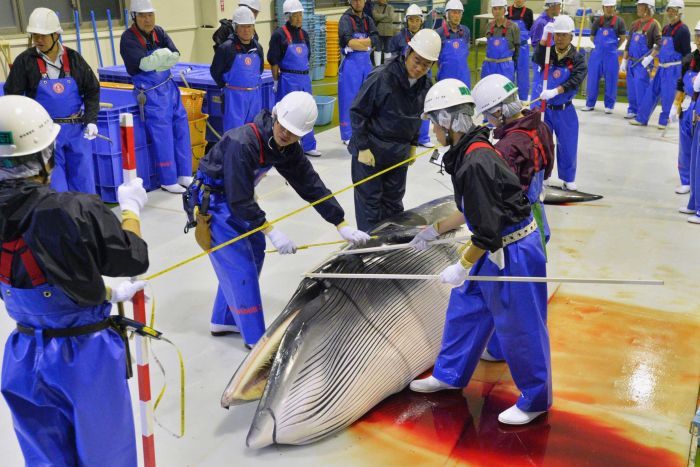
AUSTRALIA has blasted Japanese whalers for harpooning 122 pregnant whales in Antarctica this summer.
Key points:
- Japan has proposed a restructure of the IWC that would make it easier to pass decisions — a move it hopes would make it easier to resume commercial whaling.
- Australia’s Environment Minister says he will oppose any moves to weaken the decision-making process
- A Japanese MP says opposition to the consumption of whale meat is not based on science
The Human Touch
Humans are now responsible for causing changes in the environment that hurt animals and plant species. We take up more space on Earth for our homes and cities. We pollute habitats. We illegally hunt and kill animals. We bring exotic species into habitats. All of these activities take resources and habitats away from plants and the other creatures, and because the human population is growing so fast, animals and plants are disappearing 1000 times faster than they have in the past 65 million years.
It is more than unfortunate that the habitats of large numbers of plant and animal species are under threat due to human impact. Habitat loss is contributing to the permanent loss of species, and the weakening of ecosystems is impacting on both the overall health of the planet and the quality of human life.
History
There has always been some more clever than the rest of us and many others more powerful because of birth. Modern ways have not change these truths. But maybe a change in our thinking will eliminate the greed that has led us to this dangerous point by having us take on an achievable new direction. Put Earth First in all our decisions would let us end the destruction of Earth’s resources and return balance by reducing our effect on Mother Earth.
Until proven otherwise, we could also choose to believe that we are the only creatures in all we know and that Earth is the creation with mankind struggling to become a worthy head of all life. It will take time, but like losing weight we could shed the unwanted to achieve the dream of better health with a more fulfilling life by teaching our young that Earth and her creatures are the main event in our lives. Get them out to discover it’s wonder and beauty, it’s harshness, it’s a reality that injury or death awaits the foolish while fulfilment and a more meaningful life goes to the caring.
[Return to Contents]
Stop the spread of dangerous marine pests
Reprinted from Deckee.com by Jessica Watson
Commercial shipping and the water ballast systems aboard large ships have long been identified as responsible for the spread of marine pests that can wreak havoc on our marine ecosystems. As home to the port of Melbourne – Australia’s busiest container port – and to the Port of Geelong, it’s, therefore, no surprise that Port Phillip Bay is riddled with marine pests.
The most common of these is the highly invasive and predatory Northern Pacific Seastar, Asterias amurensis. Parks Victoria’s State-wide Leader – Marine and Coasts Mark Rodrigue describes the seastars as ‘voracious’. ‘They will eat essentially anything that’s not bolted down,’ say’s Mark. And, horrifyingly, at their peak there was a greater mass of the seastars than fish in the bay. Other invasive species, such as Wakame, Undaria pinnatifida, are also thriving and competing with native algae for habitat.
Roellen Gillmore, Marine Communications Officer for Parks Victoria and a keen sailor, only recently realised the extent of the problem, and what she describes an ‘opportunity to contain the marine pests’. ‘As sailors, we just aren’t aware,’ says Roe. ‘We don’t really think about what’s going on below, but there’s a whole new world under our keels.’
She explains that Wakame, Northern Pacific Seastars and their microscopic offspring can easily become attached to boats and marine equipment and spread to new waterways. While Roe jokes that she now has an environmental incentive for washing her boat down, she’s deadly serious when she says that she wouldn’t want to be the person who causes the spread. ‘Once they become established, it’s nearly impossible to get rid of them,’ say’s Roe. ‘The best management option is to prevent the spread, and it’s the human factor that we all can control.’
Thankfully these marine pests have, to date, been largely contained to Port Phillip. While some natural dispersal is unavoidable as it occurs with the tidal movements, in Victoria, New Zealand, and across the world, there is an increasing recognition that there is a danger of all vessels, including travelling boaties, unintentionally spreading pests. Past outbreaks of pests at Apollo Bay and Wilsons Promontory indicate we’re only just keeping a grip on the issue.
So while there’s already plenty on our minds as we prepare to set off through Port Phillip Heads or travel to another waterway or coastline, we also need to ensure we’re not taking dangerous stowaways with us. Here are the key things we need to do to avoid spreading marine pests;
1. Use fresh water to wash all equipment. Everything from kayaks, fishing equipment, diving gear, fenders, and anchor chain.
2. Ensure that all equipment, including sails and lines are dried as microscopic offspring can survive for long periods in the damp.
3. Yacht owners should ensure that their antifoul is kept up to date and that hulls are checked for attached marine life.
4. Sewage and bilge water should be emptied at an approved facility, and any saltwater systems on board should be flushed out or treated regularly.
5. Keep your eyes out for these pests beyond Port Phillip Bay – report sightings to marine.pests@ecodev.vic.gov.au.
While any opinions expressed by the author are absolutely her own, this article has been produced in collaboration with Parks Victoria. For more information on how boaties can prevent the spread of marine pests and report any sightings, please see Parks Victoria website.
[Return to Contents]
Bill Shorten may not be the leader we need
Geoff Cousins reveals how Bill Shorten wavered on Adani mine
Opposition leader assured environmentalist he would commit Labor to revoking the licence for the controversial coal project, but then faltered
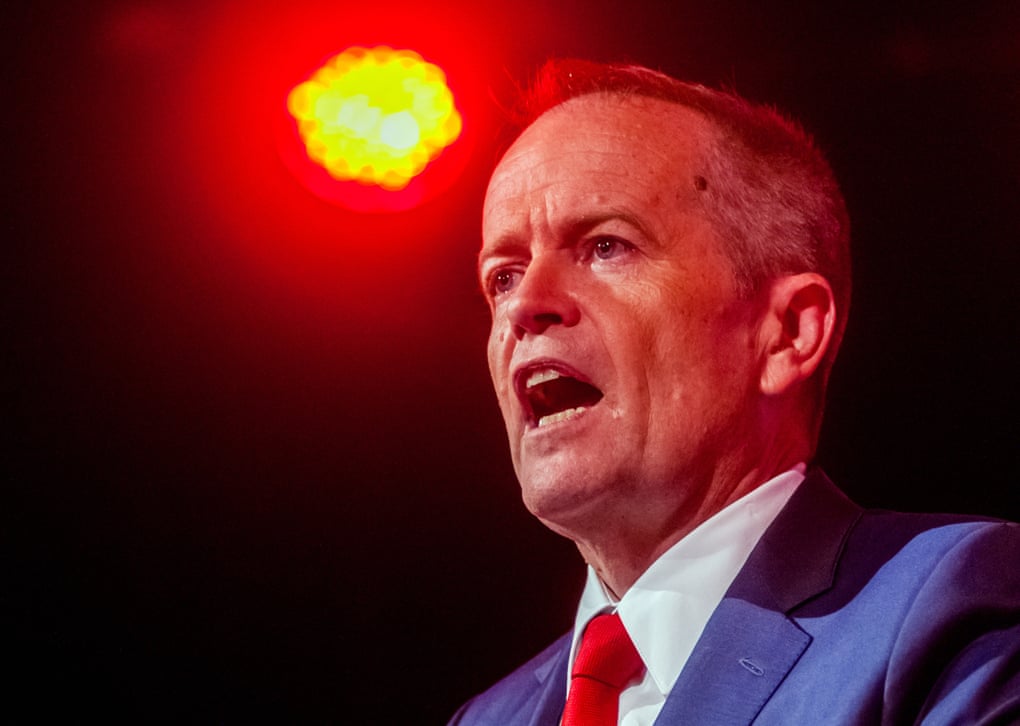
Labor leader Bill Shorten kept assuring environmentalist Geoff Cousins that he wanted to change his party’s position on Adani’s Carmichael coalmine.
Photograph: Phillip Biggs/AAP
The businessman and environmentalist Geoff Cousins is absolutely unequivocal.
He said the federal Labor leader Bill Shorten called him, just before Christmas last year, looking for help in how Labor might strengthen its policy on the controversial Adani coalmine – and then Shorten followed up several times since, asking to be given more time to convince colleagues to support the shift in position.
Read More Here This article indicates that Mr. Shorten lacks the credentials and punch to convince his colleges that stopping the Adani Mine is an election winning strategy. His answer on the issue is no longer that labour will not allow Adani to proceed, and has shifted to, when in government we will review all details and make the decision then.
Jack and Jude hope we find a strong political leader who is able to bring party support to this highly contentious situation. Does Australia allow the largest deposit of fossil fuel be developed and burnt on planet Earth for the return of export dollars. Or do we stand firm in the belief that we can find the financial return in other endeavors. We must weigh up the consequences, and resulting costs, of burning all that fossil fuel on the world’s environment. More Barrier Reef losses, more intense fires, less rain for crops.
Gunge Everywhere
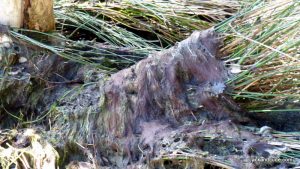 On the next windless day not long after that outing, we shifted our ship to the shores we’d cleaned during April 2017 Community Harbour Clean-up. Bloody Fish Farms! It was their idea to ‘spur on’ and get the community to clean up their mess. Well, it backfired because on that day, we and many of the community saw just how much trash ‘fish farms’ are heaping onto our shores. But, more than that, we also saw a huge amount of what Jude and I now call, GUNGE. We’ve been told it’s an endemic weed; but that it’s gone berserk with the high nutrient levels created by 5 million fish pooping in what are essentially dead waters. Ever seen what we mean? Green or red blooms on quiet waters created by high nutrient levels. Well, down here it’s a hairy GUNGE that gets blown up onto the shore vegetation and swamps it. Having seen great patches of it during last April’s Clean-up we thought we should investigate how ten months has affected the shoreline’s ecology.
On the next windless day not long after that outing, we shifted our ship to the shores we’d cleaned during April 2017 Community Harbour Clean-up. Bloody Fish Farms! It was their idea to ‘spur on’ and get the community to clean up their mess. Well, it backfired because on that day, we and many of the community saw just how much trash ‘fish farms’ are heaping onto our shores. But, more than that, we also saw a huge amount of what Jude and I now call, GUNGE. We’ve been told it’s an endemic weed; but that it’s gone berserk with the high nutrient levels created by 5 million fish pooping in what are essentially dead waters. Ever seen what we mean? Green or red blooms on quiet waters created by high nutrient levels. Well, down here it’s a hairy GUNGE that gets blown up onto the shore vegetation and swamps it. Having seen great patches of it during last April’s Clean-up we thought we should investigate how ten months has affected the shoreline’s ecology.
So we loaded our camera gear into the Green Machine and paddled to the shores we’d cleaned of trash. We’re very pleased to report that there were only nuisance bits of ropes found, along with those little individual strands that will take days, weeks, or months to clean up. Nevertheless, all the big stuff had been whisked away in the preceding couple of weeks. But the GUNGE had hardened over the reeds and grasses, and over the rocks. To the touch, it was hard and crunchy, a bit like papier-mâché, and pulling it away revealed a real sadness. The ecology had been changed! How many times have we seen this happen before when jobs and growth cloud our legislator’s minds, and we get mumbo jumbo from them that all will be right, when they really don’t know. You can’t rule if you do not get re-elected. And you may have noticed that none of them talk about human population. That’s a real no-no. But frankly, it’s we humans swamping the entire Earth with us, and our trash, and us denuding everything, be it the forests, the oceans, the wildlife, marching us swiftly to a very boring future. It’s work, work, work, till you’re too old to enjoy life or just drop dead.
We made a video clip of what we found there, starring Mr. Harry Wombat.
They’re Here Again!
Crown-of-thorns starfish eating their way through Great Barrier Reef in major outbreak
Thousands of Crown of Thorns are eating their way through coral in a major outbreak at the southern end of the Great Barrier Reef, as authorities consider how to tackle the problem.
The outbreak on the Swain Reefs off Yeppoon was discovered last year, but the area is remote and hostile, hampering efforts to control the spread of the coral-killing marine animal.
The Great Barrier Reef Marine Park Authority (GBRMPA) has confirmed it has been working out how to deal with the outbreak since last year.
The Authority’s director of education, stewardship and partnerships, Fred Nucifora, said monitoring crews went to the area to assess the problem last month. [Read More] [Listen to Podcast]
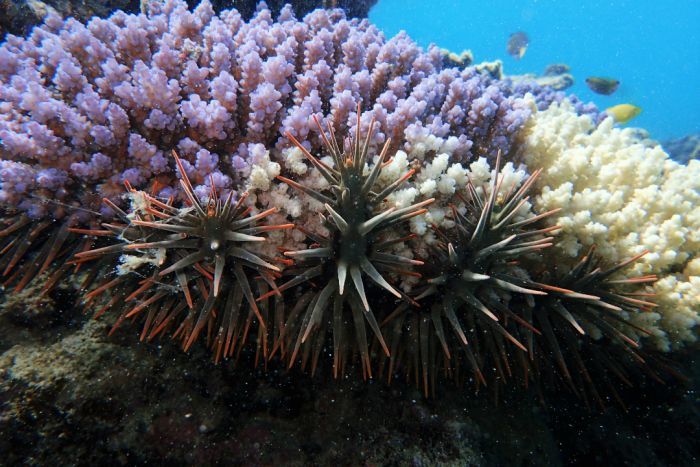
PHOTO: The poisonous barbs of a crown-of-thorns feasting on coral in the northern Great Barrier Reef. (UTS: Dr Emma Camp)





